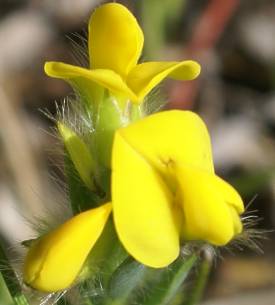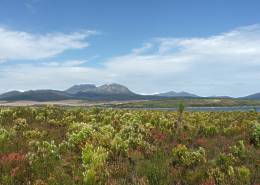Liparia angustifolia
Liparia angustifolia (Eckl. & Zeyh.) A.L.Schutte
Family: Fabaceae
Common names: none recorded
Introduction
Liparia angustifolia is an elusive little fynbos shrub growing in the understorey of lowland fynbos vegetation. It is beautiful thanks to bright yellow flowers and slender growth but is rarely seen in the wild.

Description
Description
A slender shrublet that grows to 30 cm high. The branches are lanate (woolly) with linear to narrowly lanceolate, prickly leaves. Yellow flowers are borne on hairy pedicels in a short capitate raceme. A distinguishing feature of this plant is that the flower bracts are longer than the pedicel and do not clasp the base of the calyx. Liparia angustifolia flowers in summer (October to December) and seed is generally harvested 3 months after flowering. The light brown, bean-shaped seeds are released from hairy seed pods, 20 mm in length. They use a ballistic method of seed release: once the seed pods are dry they explode releasing the seeds into the environment.

Conservation Status
Status
Liparia angustifolia is listed as Endangered on the South African Red List. The threats listed for this species include development, urbanization and invasive alien plants.The remaining populations are potentially threatened by ground water extraction. This is an irreversible threat to the species, and ground water extraction in the Hermanus area has resulted in vleis being negatively impacted. In the areas where the main populations remain, municipalities are aware that areas where the plants grow are special and have implemented measures to prevent further damage to this species.
Distribution and habitat
Distribution description
This species of Liparia historically occurred between the Cape Peninsula and Hermanus, however, due to the threats listed above, the main populations are now found along the Hermanus and Kleinmond coasts. L. angustifolia has a specific habitat and grows in lowland fynbos in vleis and marshy areas preferring the soils which remain damp. Most species of the genus Liparia are found in the southwestern Western Cape, with one species extending into the Eastern Cape Province.

Derivation of name and historical aspects
History
Liparia is a member of the Fabaceae or legume family, a large family of 650 genera and 18 000 species. The genus name Liparia is derived from the Greek word liparos which means 'shiny' or 'oily'; this refers to the hairless leaves of the genus. The species epithet angustifolia is from the Latin angustus meaning `narrow' and folium meaning `leaf'. Thus the name Liparia angustifolia means `shiny narrow leaf'.
In 1825 De Can dolle placed one species in Liparia and placed the rest of the previous Liparia species under the genera Priestleya, Rafnia or Borbonia. Later, in 1967 J.J. Bos revised the genus and added two species: L. splendens, divided into two subspecies, and L. parva. A study into the pollination mechanisms of these two species led to a 1997 revision of Priestleya and Liparia by Schutte. It was found that the species were in fact similar and Schutte returned Priestleya angustifolia to the genus Liparia, in which 21 species are at present listed.
Ecology
Ecology
Liparia angustifolia, like many legumes, has nodules on its roots that fix nitrogen into the soil.
The main pollinator of Liparia angustifolia is the carpenter bee, although other insects such as flies have been seen on the flowers. L. angustifolia is a reseeding shrublet and a resprouter. It uses both of these recruitment methods to survive fires; as the above ground parts of the plants are killed, the underground rootstock survives and produces shoots after the fire. The seeds are stimulated to germinate after a fire. The seeds of Liparia have an elaiosome which is attractive to ants, which carry the seeds underground and store them in their nests; this protects the seeds from the fire. An easy way to distinguish seedlings from resprouting plants is to count the number of stems. Those grown from seed only have a single stem whilst the resprouters have multiple stems and will flower sooner.
Uses
Use
Liparia angustifolia is not commonly cultivated due to its rarity and consequent high conservation status. It also has no known medicinal or other uses.
Growing Liparia angustifolia
Grow
This shrub it not easy to grow and the best results are achieved by copying its natural habitat requirements. It likes damp, acidic soils and needs lots of water in the winter months. It is best to grow it in flower beds in full sun or half-day shade with larger plants protecting it. Feed with an organic fertiliser and apply a mulch of well-rotted compost in spring and autumn. As fire rejuvenates older plants, mimic this by cutting the old woody stems, in the summer months, back to the rootstock and leave a few younger stems to sustain the plant.
Liparia angustifolia does not do well long-term in a container and it is recommended to plant it directly into a garden bed.
Liparia angustifolia can be propagated from seed or cuttings. Seed needs to be scarified before sowing as this will allow moisture through the seed coat and aid in germination. Sandpapering the seed coat lightly or making a shallow cut in the coat with a sharp blade will give the desired results. Next, soak the seed in warm water for 12 hours. The seed can be sown in late summer or early autumn (March-May) on a medium of sterile milled pine bark and riversand. It is important to keep the medium moist and to treat it with a fungicide to prevent loss of seedlings. Transplanting the seedlings must be done at an early age whilst still in the cotyledon stage.
Semi-hardwood heel cuttings are best taken from the rootstock or as close to the rootstock as possible. This should be done in spring to early summer or late summer to autumn. Place cuttings in a well-drained medium of milled pine bark and polystyrene. Treating the cuttings with a rooting hormone for semi-hardwood material will result in a better rooting percentage. It is best to root the cuttings directly into a large container to prevent unnecessary disturbance to the roots.
References
- Bos, J.J. & De Wit, H.C.D. 1967. The genus Liparia L. Journalof South African Botany 33(4): 269-292.
- Goldblatt, P.& Manning, J.C. 2000. Cape plants. A conspectus of the Cape flora of South Africa. Strelitzia 9. National Botanical Institute, Pretoria and Missouri Botanical Garden Press.
- Schutte, A.L. 1997. Systematics of the genus Liparia (Fabaceae). Nordic Journal of Botany 17: 11-37.
- Schutte, A.L. & Van Wyk, B-E. 1994. A reappraisal of the generic status of Liparia and Priestleya (Fabaceae). Taxon : 43: 573-582.
- Van Wyk, B-E., Verdoorn, G.H. & Greinwald, R. 1991. Taxonomic significance of alkaloids in the genus Liparia (Fabaceae - Liparieae). South African Journal Botany 57(6): 344-347.
Credits
Carly Cowell
Kirstenbosch Botanical Garden
February 2010
Plant Attributes:
Plant Type: Shrub
SA Distribution: Western Cape
Soil type: Sandy
Flowering season: Early Summer, Late Summer
PH: Acid
Flower colour: Yellow
Aspect: Full Sun, Morning Sun (Semi Shade), Afternoon Sun (Semi Shade)
Gardening skill: Challenging
Special Features:
Horticultural zones







Rate this article
Article well written and informative
Rate this plant
Is this an interesting plant?
Login to add your Comment
Back to topNot registered yet? Click here to register.